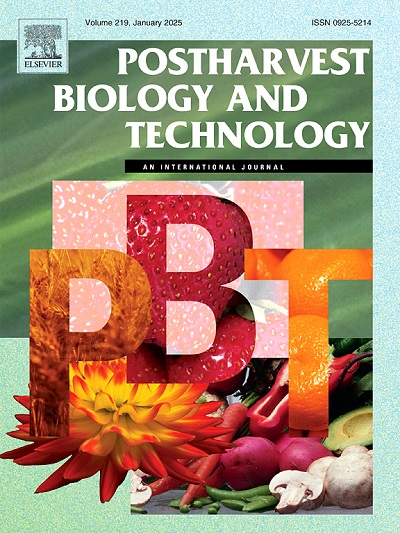草酸通过协同调节酚代谢和氧化应激延缓鲜切苹果褐变的机制
IF 6.8
1区 农林科学
Q1 AGRONOMY
引用次数: 0
摘要
草酸作为一种独特的有机酸,具有多种生理功能。在本研究中,揭示了OA处理对鲜切苹果褐变抑制的机制,尽管激活了苯酚代谢。结果表明,OA(3 mmol·L−1)处理抑制了褐变,维持了感官品质和营养物质(SSC/TA等),增强了抗氧化系统(DPPH等)。细胞超微结构完整,细胞器清晰。转录组学分析显示,185个基因参与抗氧化途径、苯丙氨酸代谢途径、类黄酮生物合成途径和抗逆性途径(TGA和PR-1)调控褐变。诱导丙酮酸含量提供稳定的能量供应。注意到,OA处理诱导了PPO、POD活性和编码基因(8/ 9,26 /31,up/total DEGs)。因此,OA处理通过抑制鲜切苹果的氧化应激、调节酚代谢、诱导能量代谢和增强抗性来减缓褐变。本文章由计算机程序翻译,如有差异,请以英文原文为准。
Mechanism of oxalic acid delaying browning of fresh-cut apples mediated by synergistic regulation of phenol metabolism and oxidative stress
Oxalic acid (OA), as a unique organic acid, has several physiological functions. In this study, the mechanism of browning inhibition was revealed by OA treatment in fresh-cut apples, despite the activation of phenol metabolism. Results showed that OA (3 mmol·L−1) treatment suppressed browning, maintained the sensory quality and nutrient substances (SSC/TA etc.), enhanced the antioxidant system (DPPH etc.). Meanwhile, the cell ultrastructure was complete and the organelles were clear. Transcriptomics analysis revealed that 185 DEGs involved in antioxidant pathway, phenylalanine metabolism, flavonoid biosynthesis pathways, and stress resistance pathway (TGA and PR-1) to regulate browning. Pyruvate content was induced to provide a stable energy supply. Noting that, the PPO, POD activities and coding genes (8/9, 26/31, up/total DEGs) were induced by OA treatment. Therefore, OA treatment attenuates browning by suppressing oxidative stress, regulating phenol metabolism, inducing energy metabolism and enhancing resistance in fresh-cut apples.
求助全文
通过发布文献求助,成功后即可免费获取论文全文。
去求助
来源期刊

Postharvest Biology and Technology
农林科学-农艺学
CiteScore
12.00
自引率
11.40%
发文量
309
审稿时长
38 days
期刊介绍:
The journal is devoted exclusively to the publication of original papers, review articles and frontiers articles on biological and technological postharvest research. This includes the areas of postharvest storage, treatments and underpinning mechanisms, quality evaluation, packaging, handling and distribution of fresh horticultural crops including fruit, vegetables, flowers and nuts, but excluding grains, seeds and forages.
Papers reporting novel insights from fundamental and interdisciplinary research will be particularly encouraged. These disciplines include systems biology, bioinformatics, entomology, plant physiology, plant pathology, (bio)chemistry, engineering, modelling, and technologies for nondestructive testing.
Manuscripts on fresh food crops that will be further processed after postharvest storage, or on food processes beyond refrigeration, packaging and minimal processing will not be considered.
 求助内容:
求助内容: 应助结果提醒方式:
应助结果提醒方式:


